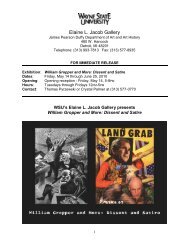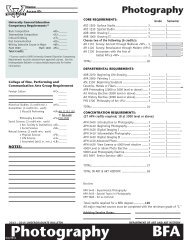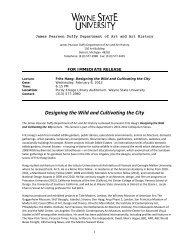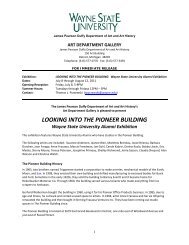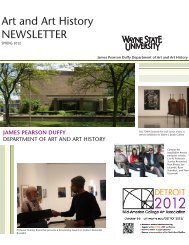linked - Department of Art and Art History - Wayne State University
linked - Department of Art and Art History - Wayne State University
linked - Department of Art and Art History - Wayne State University
You also want an ePaper? Increase the reach of your titles
YUMPU automatically turns print PDFs into web optimized ePapers that Google loves.
A panel with participating curatorial board members <strong>of</strong> the Luminale Detroit (Detroit Light Festival)<br />
will present the premiere <strong>of</strong> the Light Biennial <strong>and</strong> "Museum <strong>of</strong> the Future" emerging from new<br />
technologies. <strong>Art</strong> as not an isolated phenomenon, but as sociological reference, closely <strong>linked</strong> with<br />
technology <strong>and</strong> nature, with scientific <strong>and</strong> socio-political developments.<br />
Panelists:<br />
Berta Sichel, Curator at Large, Museo Reina S<strong>of</strong>ia, Madrid<br />
Dr. Susan Hazan, Curator <strong>of</strong> New Media, The Israel Museum, Jerusalem<br />
Octavio Zaya, Curator at Large at MUSAC, Museo de <strong>Art</strong>e Contemporáneo de Castilla y<br />
León <br />
<br />
<br />
<br />
<br />
Residual Media, <strong>Art</strong> <strong>and</strong> Collaboration <br />
Friday, October 5, 11:30 AM – 1:00 PM<br />
Founders A, Level Three, Westin Book Cadillac Hotel<br />
Chair: Chris Burnett, <strong>University</strong> <strong>of</strong> Toledo<br />
This session considers residual cultural forms <strong>and</strong> the artistic collaborations that cluster around them.<br />
“Residual” here follows Raymond Williams' usage referring to media <strong>and</strong> artifacts created in the past<br />
but still actively cling to <strong>and</strong> are meaningful in the present. The residual embraces the many ways that<br />
contemporary artists are innovatively retrieving <strong>and</strong> reevaluating discarded artifacts, fashions, <strong>and</strong><br />
older types <strong>of</strong> media. The realm <strong>of</strong> the residual may also relate to l<strong>and</strong>scape reclamation projects that<br />
reconnect the public to ab<strong>and</strong>oned sites <strong>and</strong> reorient the appeal <strong>of</strong> past ruins for the present <strong>and</strong><br />
future. Of special interest to the session is the collaborative dimension that current reclamation<br />
projects or residual media projects give rise to. In connecting residual media with art <strong>and</strong><br />
collaboration, this session address questions such as these:<br />
How do new media <strong>and</strong> old media compare as platforms <strong>of</strong> collaboration<br />
How have attitudes toward craft changed (or been restored) with collaborative involvement in<br />
residual media<br />
How do the use <strong>of</strong> found materials in art motivate collaboration in production as well as in the<br />
appreciation <strong>of</strong> collective memory<br />
What are the changing attitudes toward obsolescence <strong>and</strong> ruins, <strong>and</strong> how are they shifting from<br />
isolation <strong>and</strong> nostalgia to more dynamic, collective associations<br />
What opportunities are there for l<strong>and</strong>scape architects <strong>and</strong> artists to rebuild community as they<br />
reconstruct residual public spaces <strong>and</strong> parks<br />
Whether neglected, ab<strong>and</strong>oned, or trashed, this session explores how artistic collaboration can<br />
recycle, reconfigure, <strong>and</strong> renew a practical sense <strong>of</strong> community itself.




